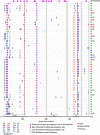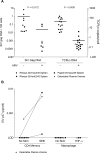Tissue-resident macrophages can contain replication-competent virus in antiretroviral-naive, SIV-infected Asian macaques
- PMID: 28239657
- PMCID: PMC5313072
- DOI: 10.1172/jci.insight.91214
Tissue-resident macrophages can contain replication-competent virus in antiretroviral-naive, SIV-infected Asian macaques
Abstract
SIV DNA can be detected in lymphoid tissue-resident macrophages of chronically SIV-infected Asian macaques. These macrophages also contain evidence of recently phagocytosed SIV-infected CD4+ T cells. Here, we examine whether these macrophages contain replication-competent virus, whether viral DNA can be detected in tissue-resident macrophages from antiretroviral (ARV) therapy-treated animals and humans, and how the viral sequences amplified from macrophages and contemporaneous CD4+ T cells compare. In ARV-naive animals, we find that lymphoid tissue-resident macrophages contain replication-competent virus if they also contain viral DNA in ARV-naive Asian macaques. The genetic sequence of the virus within these macrophages is similar to those within CD4+ T cells from the same anatomic sites. In ARV-treated animals, we find that viral DNA can be amplified from lymphoid tissue-resident macrophages of SIV-infected Asian macaques that were treated with ARVs for at least 5 months, but we could not detect replication-competent virus from macrophages of animals treated with ARVs. Finally, we could not detect viral DNA in alveolar macrophages from HIV-infected individuals who received ARVs for 3 years and had undetectable viral loads. These data demonstrate that macrophages can contain replication-competent virus, but may not represent a significant reservoir for HIV in vivo.
Conflict of interest statement
Conflict of interest: The authors have declared that no conflict of interest exists.
Figures





References
Publication types
MeSH terms
Substances
LinkOut - more resources
Full Text Sources
Other Literature Sources
Medical
Research Materials

